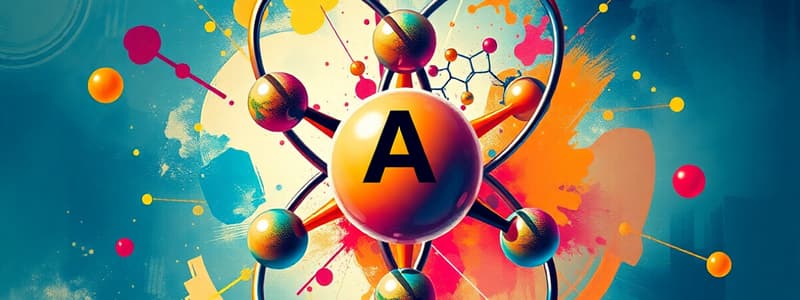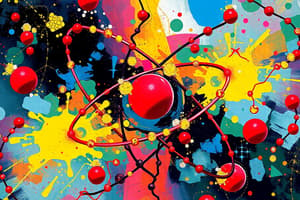Podcast
Questions and Answers
Which type of chemical bond involves the sharing of electrons between atoms?
Which type of chemical bond involves the sharing of electrons between atoms?
- Covalent bond (correct)
- Hydrogen bond
- Ionic bond
- Metallic bond
What determines the atomic number of an element?
What determines the atomic number of an element?
- The number of protons (correct)
- The number of electrons
- The mass number
- The number of neutrons
Which of the following is NOT a characteristic of a solid?
Which of the following is NOT a characteristic of a solid?
- Fixed volume
- High kinetic energy of particles (correct)
- Strong intermolecular forces
- Fixed shape
Which type of bond is responsible for the high boiling point of water?
Which type of bond is responsible for the high boiling point of water?
What is the state of matter in which electrons are stripped from atoms, forming a mixture of ions and free electrons?
What is the state of matter in which electrons are stripped from atoms, forming a mixture of ions and free electrons?
Which of the following describes the arrangement of electrons in different energy levels and sublevels within an atom?
Which of the following describes the arrangement of electrons in different energy levels and sublevels within an atom?
Which of the following is a characteristic of a nonpolar covalent bond?
Which of the following is a characteristic of a nonpolar covalent bond?
What is the difference between an atom and an ion?
What is the difference between an atom and an ion?
Which of the following best describes the role of electrons in metallic bonding?
Which of the following best describes the role of electrons in metallic bonding?
What is the primary force of attraction responsible for holding particles together in a liquid?
What is the primary force of attraction responsible for holding particles together in a liquid?
Which of the following factors does NOT directly affect the rate of a chemical reaction?
Which of the following factors does NOT directly affect the rate of a chemical reaction?
What type of chemical reaction is represented by the following equation: $2H_2 + O_2 → 2H_2O$ ?
What type of chemical reaction is represented by the following equation: $2H_2 + O_2 → 2H_2O$ ?
What is the molar mass of sodium chloride (NaCl)?
What is the molar mass of sodium chloride (NaCl)?
Which of the following statements accurately describes a solution?
Which of the following statements accurately describes a solution?
A solution with a pH of 3 is considered to be:
A solution with a pH of 3 is considered to be:
Which of the following is an example of a neutralization reaction?
Which of the following is an example of a neutralization reaction?
Which law of thermodynamics states that the total entropy of an isolated system can only increase over time?
Which law of thermodynamics states that the total entropy of an isolated system can only increase over time?
What is the enthalpy change (ΔH) of a reaction if the reaction absorbs heat from the surroundings?
What is the enthalpy change (ΔH) of a reaction if the reaction absorbs heat from the surroundings?
Which of the following statements about the Law of Conservation of Mass is TRUE?
Which of the following statements about the Law of Conservation of Mass is TRUE?
What is the function of a catalyst in a chemical reaction?
What is the function of a catalyst in a chemical reaction?
Flashcards
Atom
Atom
The fundamental building block of matter, composed of protons, neutrons, and electrons.
Proton
Proton
A positively charged particle located in the nucleus of an atom.
Neutron
Neutron
A particle with no charge located in the nucleus of an atom.
Electron
Electron
Signup and view all the flashcards
Atomic Number
Atomic Number
Signup and view all the flashcards
Mass Number
Mass Number
Signup and view all the flashcards
Isotope
Isotope
Signup and view all the flashcards
Covalent Bond
Covalent Bond
Signup and view all the flashcards
Ionic Bond
Ionic Bond
Signup and view all the flashcards
States of Matter
States of Matter
Signup and view all the flashcards
Chemical Reactions
Chemical Reactions
Signup and view all the flashcards
Reactants
Reactants
Signup and view all the flashcards
Products
Products
Signup and view all the flashcards
Chemical Equations
Chemical Equations
Signup and view all the flashcards
Law of Conservation of Mass
Law of Conservation of Mass
Signup and view all the flashcards
Stoichiometry
Stoichiometry
Signup and view all the flashcards
Solutions
Solutions
Signup and view all the flashcards
Acids
Acids
Signup and view all the flashcards
pH Scale
pH Scale
Signup and view all the flashcards
First Law of Thermodynamics
First Law of Thermodynamics
Signup and view all the flashcards
Study Notes
Atomic Structure
- Atoms are the fundamental building blocks of matter, composed of protons, neutrons, and electrons.
- Protons carry a positive charge and are located in the nucleus.
- Neutrons carry no charge and are also located in the nucleus.
- Electrons carry a negative charge and orbit the nucleus in electron shells or energy levels.
- The number of protons in an atom defines its atomic number and determines the element.
- The mass number of an atom is the sum of its protons and neutrons.
- Isotopes are atoms of the same element with different numbers of neutrons.
- Atomic mass is the average mass of all isotopes of an element, weighted by their natural abundance.
- Electron configurations describe the arrangement of electrons in different energy levels and sublevels within an atom.
Chemical Bonding
- Chemical bonds are forces of attraction that hold atoms together to form molecules or compounds.
- Ionic bonds are formed by the transfer of electrons between atoms, creating ions (charged particles).
- Covalent bonds are formed by the sharing of electrons between atoms.
- Metallic bonds are formed by the delocalization of electrons among metal atoms, creating a "sea" of electrons that allows for the flow of electricity and heat.
- Polar covalent bonds occur when atoms share electrons unequally, leading to a partial positive and partial negative charge on the atoms.
- Nonpolar covalent bonds occur when atoms share electrons equally.
- Hydrogen bonds are weak attractions between a hydrogen atom covalently bonded to a highly electronegative atom (e.g., oxygen or nitrogen) and another electronegative atom. These bonds are important for the properties of water and proteins.
- Van der Waals forces are weak attractive forces between molecules, arising from temporary and induced dipoles.
States of Matter
- Matter exists in three primary states: solid, liquid, and gas.
- Solids have a fixed shape and volume due to strong intermolecular forces holding the particles in a rigid structure.
- Liquids have a fixed volume but take the shape of their container due to weaker intermolecular forces allowing particles to move around.
- Gases have neither a fixed shape nor a fixed volume due to weak intermolecular forces and high kinetic energy of particles.
- Plasma is a state of matter where electrons are stripped from atoms, forming a mixture of ions and free electrons. Plasmas conduct electricity very well.
Chemical Reactions
- Chemical reactions involve the rearrangement of atoms to form new substances.
- Reactants are the substances that undergo change in a reaction.
- Products are the substances that are formed as a result of the reaction.
- Chemical equations represent chemical reactions using symbols and formulas to show the reactants and products.
- The Law of Conservation of Mass states that mass is neither created nor destroyed in a chemical reaction, only transformed. The number of atoms of each element must be the same on both sides of the equation.
- Types of chemical reactions include synthesis, decomposition, single displacement, double displacement, and combustion. Knowledge of reaction types helps predict possible products.
- Reaction rates are influenced by factors like temperature, concentration, surface area, and catalysts.
Stoichiometry
- Stoichiometry is the quantitative relationship between reactants and products in a chemical reaction.
- Stoichiometric calculations can be done using balanced chemical equations to determine the quantities of reactants needed or the quantities of products formed.
- Molar mass is the mass of one mole of a substance.
Solutions
- Solutions are homogeneous mixtures of two or more substances.
- Solutes are the substances that are dissolved.
- Solvents are the substances that dissolve the solutes.
- Solubility refers to the maximum amount of solute that can dissolve in a given amount of solvent at a particular temperature.
- Concentration expresses the amount of solute present in a given amount of solution and can be expressed in many ways such as molarity, molality, and percent by mass.
- Factors that affect solubility include temperature, pressure and nature of solute/solvent.
Acids and Bases
- Acids are substances that produce hydrogen ions (H+) when dissolved in water.
- Bases are substances that produce hydroxide ions (OH-) when dissolved in water.
- pH is a measure of the concentration of hydrogen ions in a solution. pH ranges from 0 to 14.
- Neutralization reactions occur when acids and bases react to form salt and water.
- Buffers are solutions that resist changes in pH when small amounts of acid or base are added.
Thermodynamics
- Thermodynamics deals with the energy changes in chemical and physical processes.
- The first law of thermodynamics states that energy can be neither created nor destroyed, only transformed.
- The second law of thermodynamics states that the total entropy of an isolated system can only increase over time.
- The third law of thermodynamics states that the entropy of a perfect crystal at absolute zero is zero.
- Enthalpy (ΔH) is the heat absorbed or released in a reaction at constant pressure.
- Entropy (ΔS) is a measure of the randomness or disorder in a system.
Studying That Suits You
Use AI to generate personalized quizzes and flashcards to suit your learning preferences.




